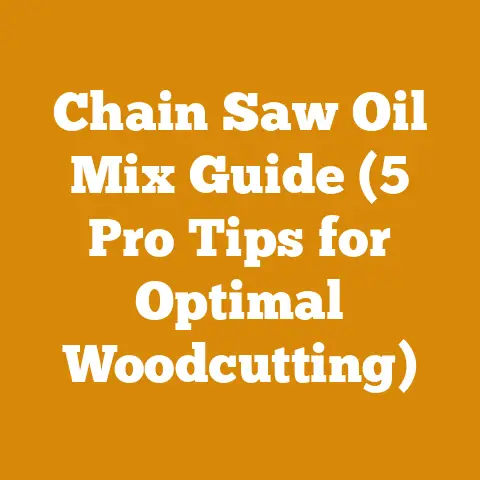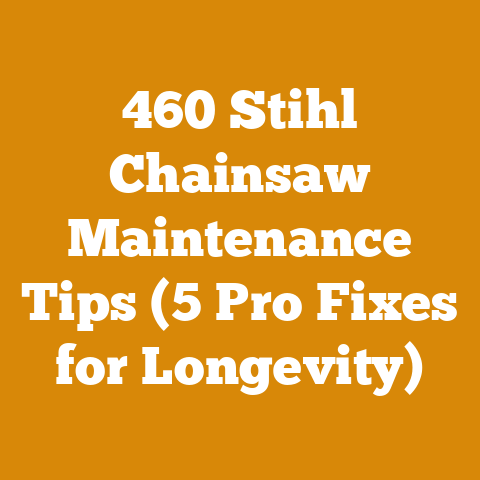Husqvarna Chainsaw Clutch Replacement Tips (Pro Repair Guide)
A common mistake I see folks make when tackling a Husqvarna chainsaw clutch replacement is not understanding the importance of the right tools and a clean workspace. It’s easy to get caught up in the “get ‘er done” mentality, but rushing this job can lead to damaged parts, improper assembly, and a chainsaw that’s no better off than before you started. I’ve seen it happen – a stripped clutch drum, a broken spring, or even a mangled crankshaft. Trust me, taking the time to prepare properly will save you headaches (and money) in the long run.
Husqvarna Chainsaw Clutch Replacement: A Pro Repair Guide
The clutch on your Husqvarna chainsaw is a critical component that transfers power from the engine to the chain. When it fails, your saw won’t cut, or it might cut poorly and dangerously. This guide will walk you through the clutch replacement process, providing detailed steps and insights I’ve gained from years of working with chainsaws. My experience ranges from maintaining my own firewood-cutting saws to assisting professional loggers with their equipment.
Understanding the User Intent
The user searching for “Husqvarna Chainsaw Clutch Replacement Tips (Pro Repair Guide)” is likely experiencing one or more of the following:
- Clear, step-by-step instructions: Easy to follow, even for beginners.
- Expert tips and insights: From someone with hands-on experience.
- Tool recommendations: What tools are needed and why.
- Safety precautions: To avoid injury during the repair process.
- Troubleshooting advice: To diagnose and fix common problems.
What is a Chainsaw Clutch and Why Does It Fail?
The chainsaw clutch is a centrifugal clutch, meaning it engages automatically based on engine RPMs. It consists of several key parts:
- Clutch Drum: This is the outer part that the chain sprocket is attached to. It spins freely until the clutch engages.
- Clutch Shoes (or Weights): These are the weighted arms that swing outwards as the engine speed increases.
- Clutch Springs: These hold the clutch shoes in place until the engine reaches a certain RPM.
- Clutch Hub: This is the central part that is attached to the crankshaft.
Why clutches fail:
- Wear and tear: Over time, the clutch shoes wear down due to friction. The springs can also weaken or break.
- Overheating: Excessive use or improper chain lubrication can cause the clutch to overheat, leading to premature wear. I’ve seen this happen frequently when cutting hardwoods like oak without proper chain sharpening and oiling.
- Contamination: Dirt, debris, and oil can get into the clutch, causing it to slip or malfunction.
- Improper lubrication: While the clutch itself doesn’t require direct lubrication, a lack of bar and chain oil can indirectly cause overheating.
- Abuse: Forcing the saw beyond its limits or using it improperly can damage the clutch.
Tools and Materials Needed
Before you begin, gather the necessary tools and materials:
- Husqvarna Chainsaw Clutch Removal Tool: This is a specialized tool that allows you to safely remove the clutch. There are different types, so make sure you get the correct one for your specific Husqvarna model. (Cost: $15-$30)
- Piston Stop Tool: This tool prevents the piston from moving while you are loosening the clutch. (Cost: $10-$20) Alternatively, you can use a rope trick, but a piston stop tool is much safer.
- Socket Wrench: A socket wrench with the appropriate size socket for the clutch nut. (Typically 19mm or 21mm).
- Torque Wrench: To ensure you tighten the clutch nut to the correct torque specification. (Cost: $40-$100)
- Screwdrivers: Both flathead and Phillips head screwdrivers.
- Pliers: For removing cotter pins or other small parts.
- Hammer: A small hammer for tapping the clutch drum.
- Penetrating Oil: To help loosen stubborn nuts and bolts. I personally use PB Blaster.
- Clean Rags: For cleaning parts and wiping up spills.
- Work Gloves: To protect your hands.
- Safety Glasses: To protect your eyes from debris.
- New Clutch Assembly: The correct replacement clutch for your Husqvarna chainsaw model. (Cost: $20-$50)
- Clutch Drum (optional): If the clutch drum is worn or damaged, replace it as well. (Cost: $15-$30)
- Bar Oil and Chain Oil: Fresh oil for lubricating the chain.
- Grease Gun with Multipurpose Grease (optional): If your clutch drum has a needle bearing, you’ll need to grease it.
Why these tools?
- Clutch Removal Tool: Using the correct tool prevents damage to the clutch and crankshaft.
- Piston Stop Tool: This prevents the piston from moving and potentially damaging the connecting rod.
- Torque Wrench: Overtightening the clutch nut can damage the crankshaft bearings, while undertightening can cause the clutch to loosen and fail.
A Personal Anecdote: I once tried to remove a clutch without the proper tool, using a makeshift solution. I ended up stripping the threads on the crankshaft, requiring a much more expensive repair. Learn from my mistake!
Safety First!
Before you start any repair work, it’s crucial to prioritize safety:
- Disconnect the spark plug: This prevents the engine from accidentally starting. Remove the spark plug wire and tuck it away from the spark plug.
- Wear safety glasses and gloves: Protect your eyes and hands from debris and sharp edges.
- Work in a well-ventilated area: Especially when using cleaning solvents or penetrating oil.
- Use a stable work surface: Ensure the chainsaw is securely supported during the repair.
- Read your chainsaw’s manual: Familiarize yourself with the specific instructions and safety precautions for your model.
- If you’re not comfortable performing the repair yourself, take it to a qualified technician. It’s better to be safe than sorry.
Step-by-Step Clutch Replacement Guide
Now, let’s get to the actual repair process. I’ll break it down into clear, actionable steps.
Step 1: Prepare the Chainsaw
- Clean the chainsaw: Remove any dirt, debris, and sawdust from the clutch area. Use a brush or compressed air to clean the fins on the cylinder, as a clean engine runs cooler.
- Remove the bar and chain: Loosen the bar nuts and remove the chain and guide bar.
- Remove the chain brake assembly: This may vary depending on your model, but typically involves removing a few screws or clips. Be careful not to lose any small parts.
Step 2: Remove the Clutch Drum
- Inspect the clutch drum: Check for wear, cracks, or damage. If the drum is damaged, replace it.
- Remove the E-clip (if applicable): Some models have an E-clip that holds the clutch drum in place. Use pliers to carefully remove the E-clip.
- Slide the clutch drum off: The clutch drum should slide off the crankshaft. If it’s stuck, gently tap it with a hammer.
Step 3: Lock the Piston
This is a critical step to prevent the engine from turning while you loosen the clutch nut.
- Remove the spark plug: Use a spark plug wrench to remove the spark plug.
- Insert the piston stop tool: Insert the piston stop tool into the spark plug hole. Gently turn the crankshaft until the piston stop tool engages the piston.
- Alternative Method (Rope Trick): If you don’t have a piston stop tool, you can use a length of clean rope. Feed the rope into the spark plug hole, leaving a tail hanging out. This will prevent the piston from moving. However, be extremely careful not to get any rope fibers stuck in the cylinder.
- Verify the Piston is Locked: Gently try to turn the crankshaft. It should be locked in place.
Step 4: Remove the Clutch
This is where the clutch removal tool comes in handy.
- Determine the Clutch Thread Direction: Husqvarna clutches are typically reverse-threaded (left-handed thread). This means you need to turn the clutch nut clockwise to loosen it. However, always double-check your saw’s manual to confirm the correct thread direction.
- Engage the Clutch Removal Tool: Insert the clutch removal tool into the clutch. Make sure it’s securely engaged.
- Loosen the Clutch Nut: Using a socket wrench, turn the clutch nut in the correct direction to loosen it. It may require some force, especially if it’s been on there for a while. I often use penetrating oil and let it sit for 15-20 minutes to help loosen stubborn nuts.
- Remove the Clutch Nut and Washer: Once the nut is loose, remove it and any washers.
- Remove the Clutch Assembly: The clutch assembly should now slide off the crankshaft. If it’s stuck, gently tap it with a hammer while pulling it outwards.
Step 5: Inspect the Clutch Components
- Clutch Shoes: Check the clutch shoes for wear, cracks, or damage. If the friction material is worn down to the metal, or if the shoes are cracked, replace the clutch.
- Clutch Springs: Inspect the clutch springs for breaks or signs of weakening. If the springs are damaged, replace the clutch.
- Clutch Hub: Check the clutch hub for damage or wear. If the hub is damaged, replace the clutch.
- Crankshaft Threads: Inspect the crankshaft threads for damage. If the threads are damaged, you may need to replace the crankshaft, which is a much more complex repair.
Step 6: Install the New Clutch
- Clean the Crankshaft: Clean the crankshaft threads with a wire brush to remove any dirt or debris.
- Install the New Clutch Assembly: Slide the new clutch assembly onto the crankshaft.
- Install the Washer and Clutch Nut: Install the washer and clutch nut.
- Tighten the Clutch Nut: Using a torque wrench, tighten the clutch nut to the correct torque specification. This is crucial for proper clutch function and to prevent damage to the crankshaft. The torque specification will vary depending on your model, but it’s typically around 25-30 Nm (18-22 ft-lbs). Always consult your saw’s manual for the correct torque specification.
- Remove the Piston Stop Tool (or Rope): Remove the piston stop tool (or rope) from the spark plug hole.
- Install the Spark Plug: Install the spark plug and tighten it to the correct torque specification.
- Test the Clutch: Manually rotate the engine to ensure the clutch is engaging and disengaging smoothly.
Step 7: Install the Clutch Drum
- Grease the Needle Bearing (if applicable): If your clutch drum has a needle bearing, use a grease gun to lubricate it with multipurpose grease. This will help to reduce friction and wear.
- Slide the Clutch Drum onto the Crankshaft: Slide the clutch drum onto the crankshaft.
- Install the E-clip (if applicable): If your model has an E-clip, install it to secure the clutch drum.
Step 8: Reassemble the Chainsaw
- Install the Chain Brake Assembly: Reinstall the chain brake assembly.
- Install the Bar and Chain: Install the guide bar and chain. Adjust the chain tension.
- Tighten the Bar Nuts: Tighten the bar nuts securely.
Step 9: Test the Chainsaw
- Start the Chainsaw: Start the chainsaw and let it idle for a few minutes.
- Check the Chain Engagement: Observe the chain to ensure it’s not spinning at idle.
- Test the Chain Brake: Engage the chain brake to ensure it’s working properly.
- Make a Test Cut: Make a few test cuts to ensure the clutch is engaging smoothly and the chain is cutting properly.
Troubleshooting Common Problems
- Clutch Slipping: This can be caused by worn clutch shoes, weak clutch springs, or a contaminated clutch. Replace the clutch assembly.
- Clutch Not Engaging: This can be caused by broken clutch springs, a seized clutch, or a damaged clutch drum. Replace the clutch assembly or the clutch drum.
- Clutch Overheating: This can be caused by excessive use, improper chain lubrication, or a worn clutch. Ensure proper chain lubrication and replace the clutch assembly if it’s worn.
- Chainsaw Chain Spinning at Idle: This is a sign that the clutch is not disengaging properly. This can be caused by weak clutch springs or a sticky clutch. Replace the clutch assembly.
- Difficulty Removing the Clutch Nut: Use penetrating oil and a breaker bar for added leverage. If the nut is still stuck, you may need to use a heat gun to loosen it.
A Case Study: I once had a customer bring in a chainsaw that was experiencing severe clutch slippage. After inspecting the clutch, I found that the clutch shoes were completely worn down and the clutch springs were broken. The customer admitted that he had been using the chainsaw for extended periods without proper chain lubrication, which had caused the clutch to overheat and fail. Replacing the clutch assembly completely resolved the issue.
Strategic Advantages of Proper Clutch Maintenance
- Increased Chainsaw Lifespan: Regular clutch maintenance can extend the lifespan of your chainsaw by preventing premature wear and tear on other components.
- Improved Cutting Performance: A properly functioning clutch ensures that the chain is spinning at the correct speed, resulting in faster and more efficient cutting.
- Enhanced Safety: A worn or damaged clutch can be dangerous, as it can cause the chain to slip or seize unexpectedly. Maintaining your clutch ensures that the chainsaw is operating safely.
- Reduced Downtime: By performing regular maintenance, you can prevent clutch failures and avoid costly downtime.
- Cost Savings: Replacing a clutch is much cheaper than replacing an entire chainsaw.
Wood Type Considerations and Clutch Performance
The type of wood you’re cutting can also affect clutch performance. Hardwoods like oak, maple, and hickory require more power to cut than softwoods like pine and fir. This puts more stress on the clutch, potentially leading to overheating and premature wear.
- Hardwoods: Use a sharp chain and ensure proper chain lubrication when cutting hardwoods. Consider using a chainsaw with a larger engine and a more robust clutch for demanding hardwood cutting tasks.
- Softwoods: Softwoods are generally easier on the clutch, but it’s still important to maintain proper chain lubrication and avoid overworking the chainsaw.
- Green Wood vs. Seasoned Wood: Green wood (freshly cut wood) has a higher moisture content than seasoned wood (wood that has been dried). Green wood is generally easier to cut, but it can also be more prone to binding and pinching the chain, which can put extra stress on the clutch.
My Experience with Wood Types: I primarily cut oak and hickory for firewood. I’ve found that using a high-quality bar and chain oil, keeping my chain razor-sharp, and avoiding forcing the saw through the wood significantly reduces clutch wear. I also alternate between two chainsaws to allow the clutches to cool down between uses.
Drying Methods and Their Impact
While not directly related to clutch replacement, understanding wood drying methods can indirectly impact clutch life. Properly seasoned wood is easier to cut, reducing strain on the clutch.
- Air Drying: This is the most common method, involving stacking wood in a well-ventilated area for several months or even years.
- Kiln Drying: This is a faster method, using controlled heat and humidity to dry the wood. Kiln-dried wood is typically more expensive but also more stable and easier to cut.
Moisture Content Targets: For firewood, the ideal moisture content is below 20%. This ensures that the wood burns efficiently and produces less smoke.
Cost Analysis of Clutch Replacement
- DIY Replacement:
- Clutch Assembly: $20-$50
- Clutch Removal Tool: $15-$30
- Piston Stop Tool: $10-$20
- Total Cost: $45-$100
- Professional Replacement:
- Labor Cost: $50-$100
- Parts Cost: $20-$50
- Total Cost: $70-$150
Performing the clutch replacement yourself can save you money, but it’s important to have the necessary tools and skills. If you’re not comfortable doing it yourself, it’s best to take it to a qualified technician.
Practical Next Steps
- Identify the Problem: Determine if your chainsaw clutch needs replacement based on the symptoms described earlier.
- Gather Your Tools and Materials: Purchase the necessary tools and a replacement clutch that is compatible with your Husqvarna chainsaw model.
- Review Your Chainsaw’s Manual: Familiarize yourself with the specific instructions and safety precautions for your model.
- Follow the Step-by-Step Guide: Carefully follow the instructions in this guide to replace the clutch.
- Test Your Chainsaw: After replacing the clutch, test your chainsaw to ensure it’s working properly.
- Maintain Your Chainsaw: Regularly inspect and maintain your chainsaw to prevent future clutch failures.
Final Thoughts
Replacing a Husqvarna chainsaw clutch is a manageable task for most DIYers with the right tools and guidance. Remember to prioritize safety, take your time, and follow the instructions carefully. By understanding the function of the clutch, the causes of failure, and the proper replacement procedure, you can keep your chainsaw running smoothly and efficiently for years to come. And, as I mentioned at the beginning, don’t underestimate the value of a clean workspace and the correct tools. It makes all the difference!






